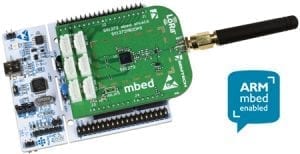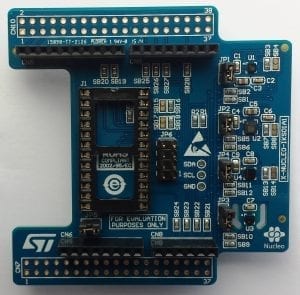Whether it was the roads of Ancient Rome leading to the Milliarium Aureum or the worldwide trenches of the “information superhighway,” all groundbreaking networks have one thing in common: they are always greater than the sum of their parts. Cellular networks are now more than simply phones that talk to a cell tower, they are gateways to hyper-connectivity. The Internet is much more than a bunch of clients receiving packets from servers, but the revolution of the digital age. And now, as smart cities rise thanks to the increasing popularity of smart devices, one may wonder what technology will bring the Internet of Things together, with its sensors and battery-powered devices, to create something greater than the sum of its parts.
LoRa™ has answered this call by providing a secure, reliable, and powerful technology, which ST is making easily accessible to all developers and engineers. Thanks to the P-NUCLEO-LRWAN1 development board, the I-CUBE LRWAN middleware stack and the X-NUCLEO-IKS01A1 that includes motion and environmental sensors, being ready for the network of tomorrow starts now.
LoRa™: Coverage and Security
LoRa™, which is short for LoRaWAN (Long Range Wireless Area Network) is a type to LPWAN (Low Power Wide Area Network). Developed by Semtech and governed by the LoRa Alliance™, of which ST is a member. LoRa™ uses sub-gigahertz bands to connect devices which means that data rates are low (from 0.3 Kb/s to 50 Kb/s), but since messages are very basic this not an issue. However, using such spectrum also implies that connections can extend over great distances. A LoRaWAN can extend more than 15 kilometers (about 9 miles) in deserted areas and more than 2 kilometers (about 1 mile) in densely populated environments.
The LoRa Alliance understands that data transmitted can contain very sensitive and private information. Thus, LoRa™ uses three different levels of encryption. There’s a unique key at the network level, a unique application key ensuring the encryption of end to end transmissions, and each device also uses a specific key to protect its data.
LoRa™: Reliability and Efficiency
 LoRa™ uses a practical star-of-stars (also known as extended star) topology. This means that end-devices (sensors monitoring garbage collection, smart meters, etc.) talk to a gateway that simply acts as a bridge to the central server. Hence, if one node (end device) breaks, the network remains unaffected which also implies that it is possible to add or subtract nodes without disturbing the network, a fundamental feature when linking an entire city. Furthermore, the technology is very scalable, since one network can accommodate up to one million nodes.
LoRa™ uses a practical star-of-stars (also known as extended star) topology. This means that end-devices (sensors monitoring garbage collection, smart meters, etc.) talk to a gateway that simply acts as a bridge to the central server. Hence, if one node (end device) breaks, the network remains unaffected which also implies that it is possible to add or subtract nodes without disturbing the network, a fundamental feature when linking an entire city. Furthermore, the technology is very scalable, since one network can accommodate up to one million nodes.
LoRa is also reliable thanks to its patented modulation processes. Using a spread-spectrum technique, meaning that the signal is spread over a wider bandwidth, it is able to better deal with interference while keeping energy consumption at a minimum. As such, certain LoRa end-devices can last over 10 years on a single battery.
ST’s 3-in-1 Solution

To easily develop solutions that take advantage of this forward-thinking technology, ST released the P-NUCLEO-LRWAN1 pack that includes a NUCLEO-L073RZ board and the Semtech SX1272MB2xAS LoRa™ expansion board. This means that engineers can take advantage of an ultra-low power 32-bit ARM M0+ MCU, a powerful SX1272 transceiver, and a middleware stack, the I-CUBE-LRWAN, that provides dedicated APIs and templates to build and test a LoRA connected device in no time using those components.
Indeed, the pack comes with two firmware examples, one of which sets up the P-NUCLEO-LRWAN1 as an end-device that immediately tries to link with a gateway. Getting it running is simply a matter of following the four steps outlined in the publicly available documentation and use one of the many getaways available on the market or simply use a Raspberry Pi B+ from Semtech, which will act as a gateway and server for test purposes.
What makes this development kit even more powerful is that the NUCLEO-L073RZ can also be paired with the X-NUCLEO-IKS01A1 expansion that includes an accelerometer, a magnetometer, a pressure sensor, a hygrometer, as well as a thermometer. Hence, ST is in a unique position to deliver all the pieces for engineers to start making LoRa compatible smart devices in record time.
It Has Already Begun
Cities, like Amsterdam, have already jumped on the LoRa™ bandwagon, but consumer devices are also benefiting from this network. The technology has found applications in private as well as public networks. From telecom operators to manufacturers of enterprise and consumer solutions, LoRaWAN has already begun to bring the Internet of Things together, making it the next great network of our time.
You can learn more about ST’s LoRa™ solutions by visiting its website.




